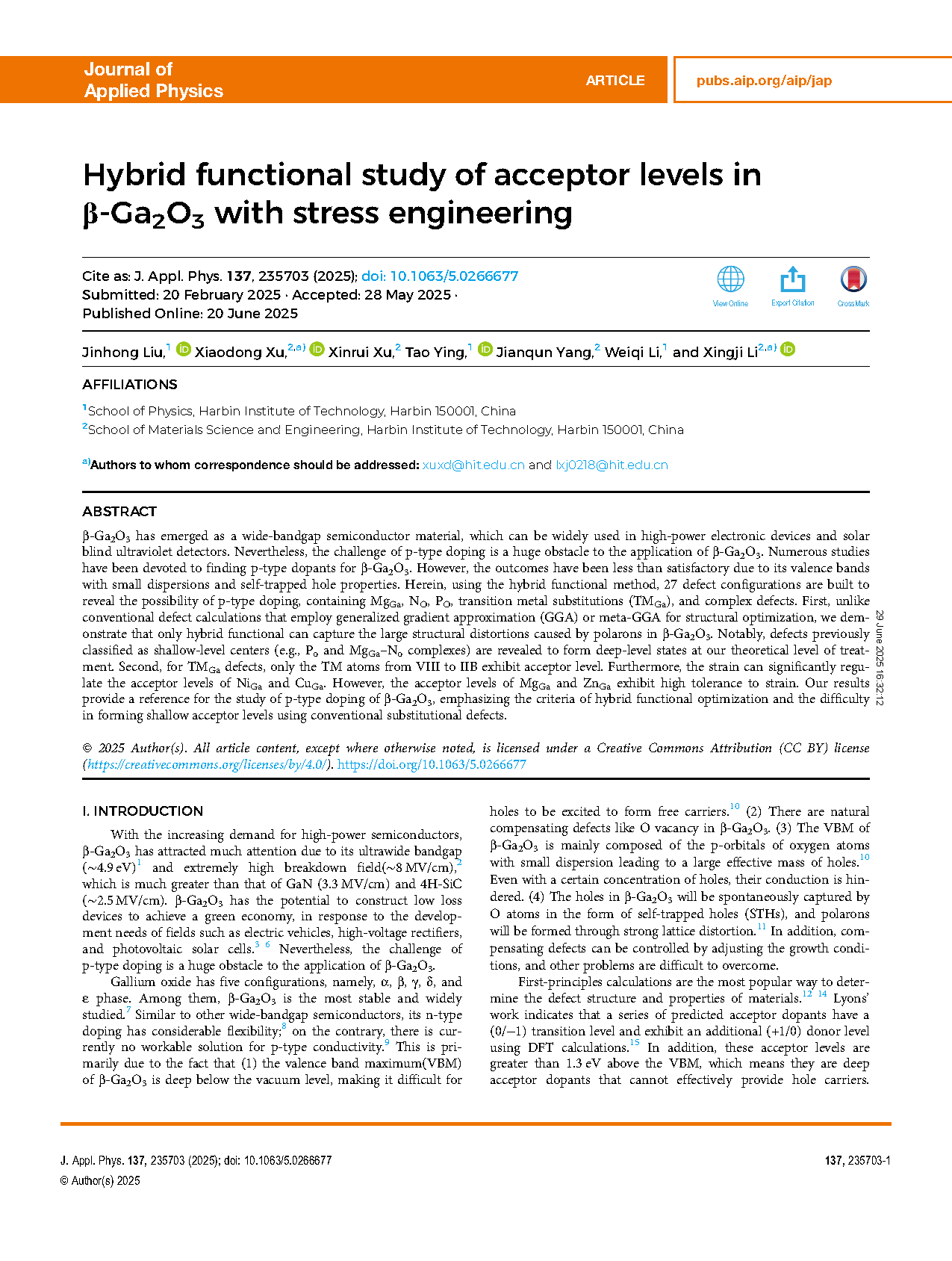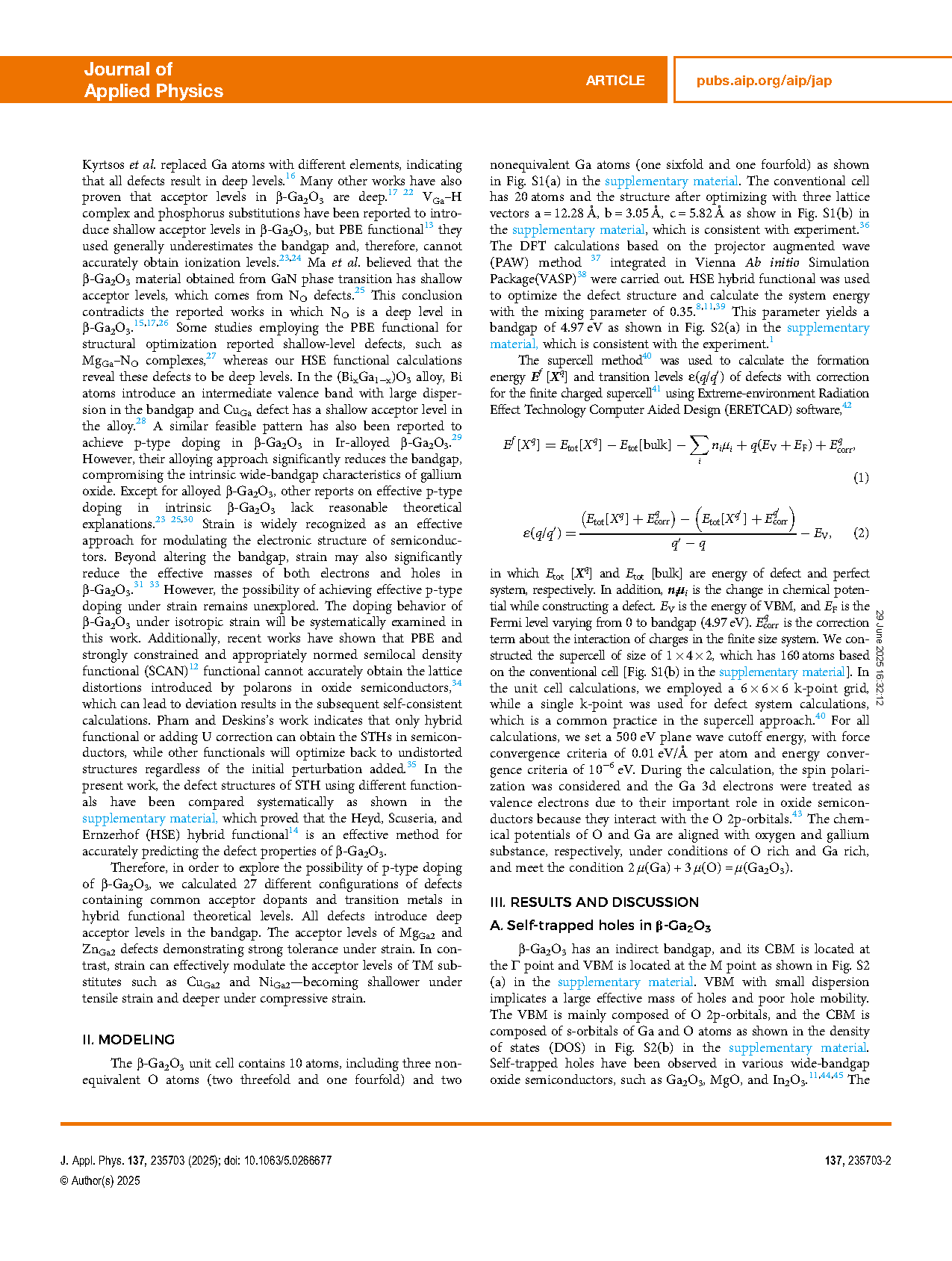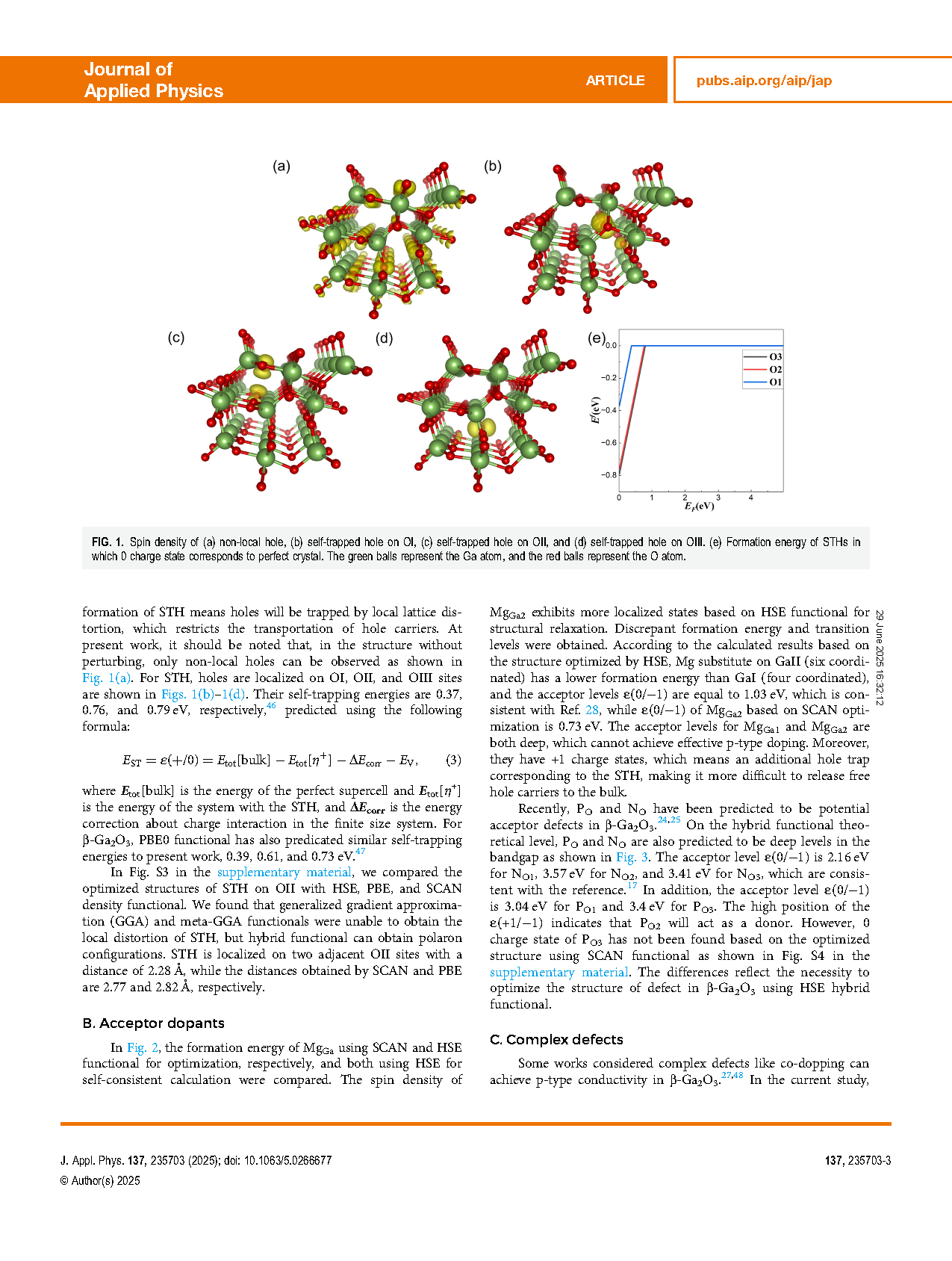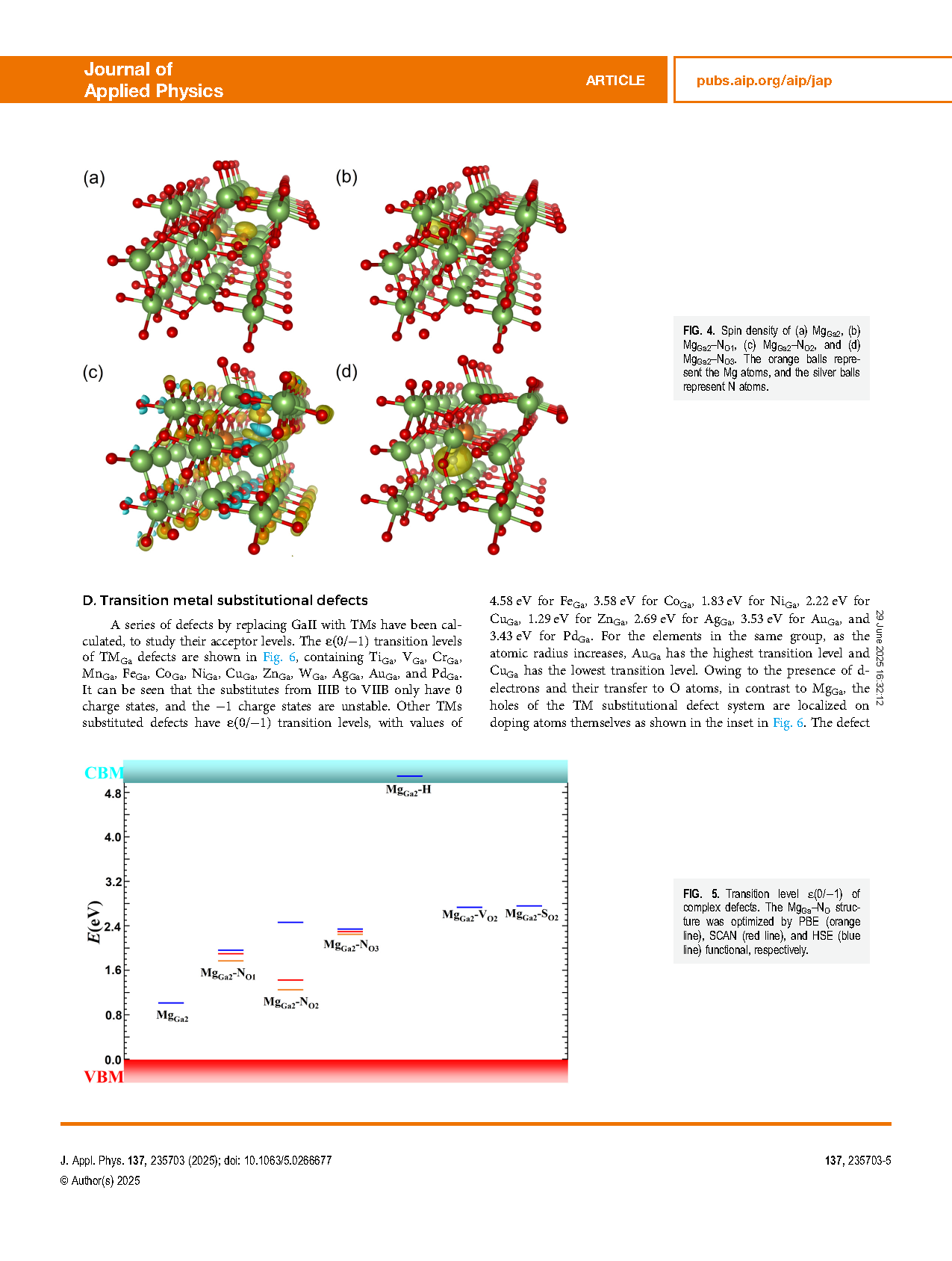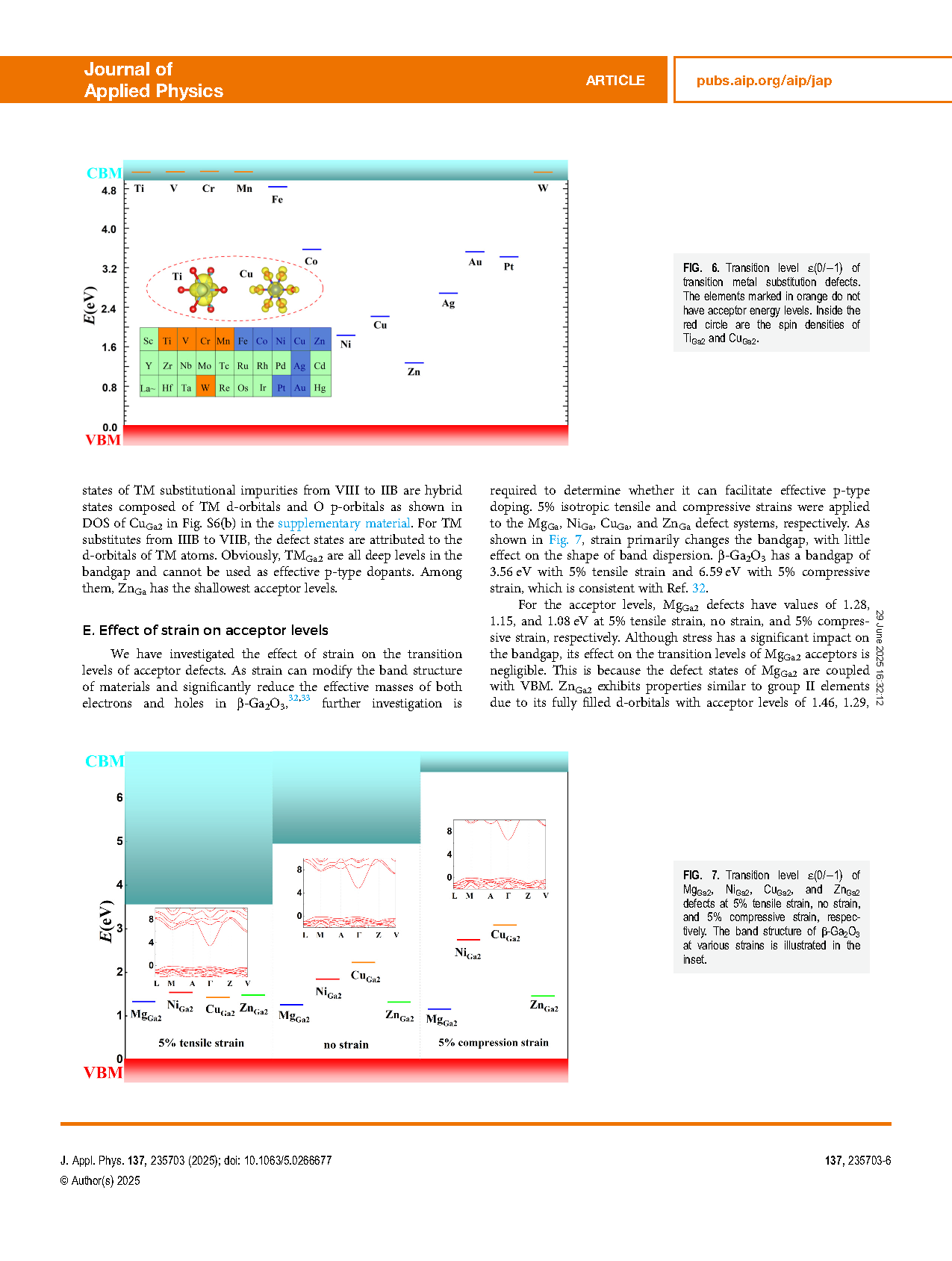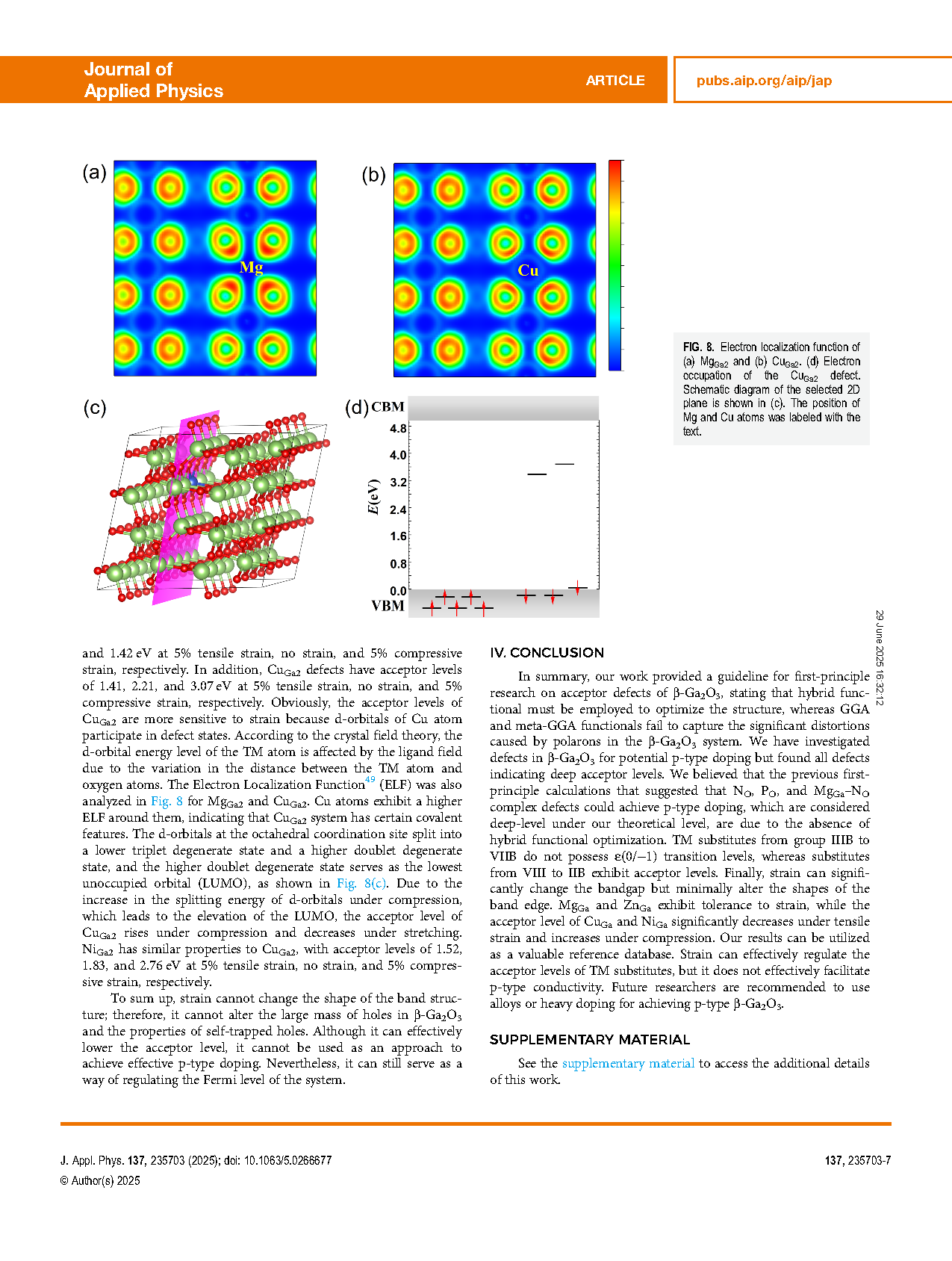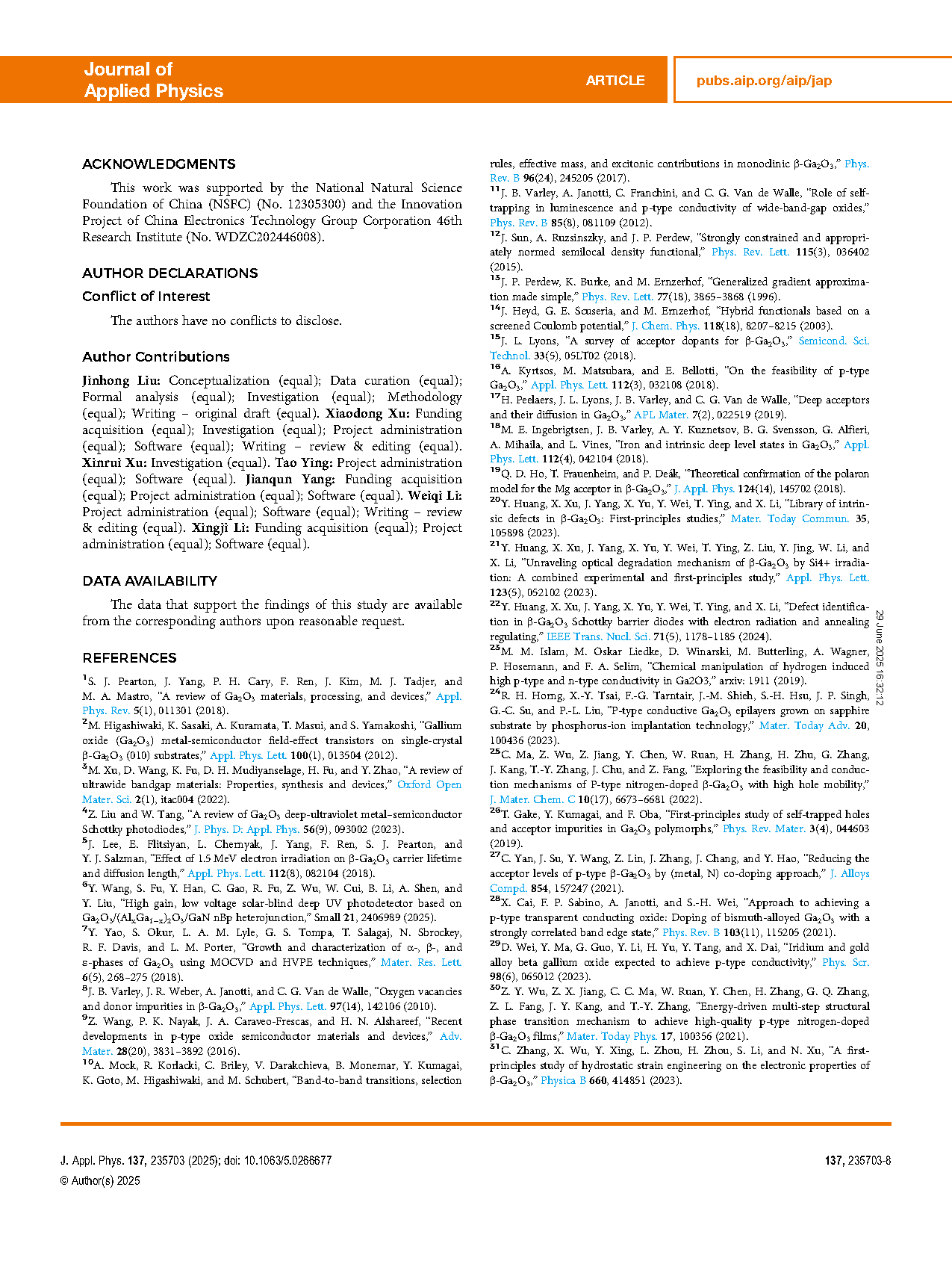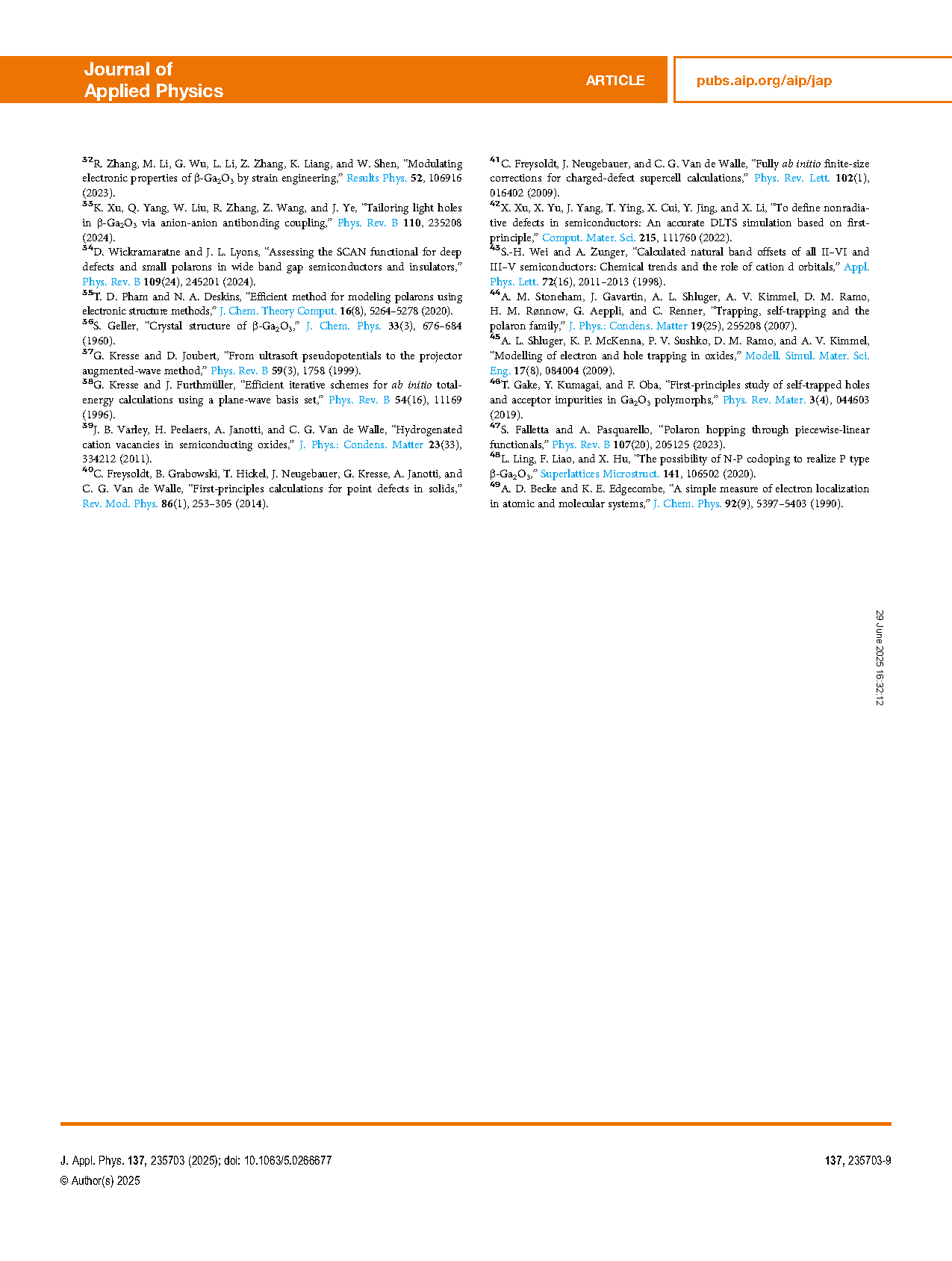
【Domestic Papers】Hybrid functional study of acceptor levels in β-Ga₂O₃ with stress engineering
日期:2025-07-08阅读:256
Researchers from the Harbin Institute of Technology have published a dissertation titled "Hybrid functional study of acceptor levels in β-Ga2O3 with stress engineering" in Journal of Applied Physics.
Project Support
This work was supported by the National Natural Science Foundation of China (NSFC) (No. 12305300) and the Innovation Project of China Electronics Technology Group Corporation 46th Research Institute (No. WDZC202446008).
Background
With the increasing demand for high-power semiconductors, β-Ga2O3 has attracted much attention due to its ultrawide bandgap (∼4.9 eV) and extremely high breakdown field(∼8 MV/cm), which is much greater than that of GaN (3.3 MV/cm) and 4H-SiC(∼2.5 MV/cm). β-Ga2O3 has the potential to construct low loss devices to achieve a green economy, in response to the development needs of fields such as electric vehicles, high-voltage rectifiers, and photovoltaic solar cells. Nevertheless, the challenge of p-type doping is a huge obstacle to the application of β-Ga2O3.
Gallium oxide has five configurations, namely, α, β, γ, δ, and ɛ phase. Among them, β-Ga2O3 is the most stable and widely studied. Similar to other wide-bandgap semiconductors, its n-type doping has considerable flexibility; on the contrary, there is currently no workable solution for p-type conductivity. This is primarily due to the fact that (1) the valence band maximum(VBM) of β-Ga2O3 is deep below the vacuum level, making it difficult for holes to be excited to form free carriers. (2) There are natural compensating defects like O vacancy in β-Ga2O3. (3) The VBM of β-Ga2O3 is mainly composed of the p-orbitals of oxygen atoms with small dispersion leading to a large effective mass of holes. Even with a certain concentration of holes, their conduction is hindered. (4) The holes in β-Ga2O3 will be spontaneously captured by O atoms in the form of self-trapped holes (STHs), and polarons will be formed through strong lattice distortion. In addition, compensating defects can be controlled by adjusting the growth conditions, and other problems are difficult to overcome.
Abstract
β-Ga2O3 has emerged as a wide-bandgap semiconductor material, which can be widely used in high-power electronic devices and solar blind ultraviolet detectors. Nevertheless, the challenge of p-type doping is a huge obstacle to the application of β-Ga2O3. Numerous studies have been devoted to finding p-type dopants for β-Ga2O3. However, the outcomes have been less than satisfactory due to its valence bands with small dispersions and self-trapped hole properties. Herein, using the hybrid functional method, 27 defect configurations are built to reveal the possibility of p-type doping, containing MgGa, NO, PO, transition metal substitutions (TMGa), and complex defects. First, unlike conventional defect calculations that employ generalized gradient approximation (GGA) or meta-GGA for structural optimization, we demonstrate that only hybrid functional can capture the large structural distortions caused by polarons in β-Ga2O3. Notably, defects previously classified as shallow-level centers (e.g., Po and MgGa–No complexes) are revealed to form deep-level states at our theoretical level of treatment. Second, for TMGa defects, only the TM atoms from VIII to IIB exhibit acceptor level. Furthermore, the strain can significantly regulate the acceptor levels of NiGa and CuGa. However, the acceptor levels of MgGa and ZnGa exhibit high tolerance to strain. Our results provide a reference for the study of p-type doping of β-Ga2O3, emphasizing the criteria of hybrid functional optimization and the difficulty in forming shallow acceptor levels using conventional substitutional defects.
Conclusion
In summary, our work provided a guideline for first-principle research on acceptor defects of β-Ga2O3, stating that hybrid functional must be employed to optimize the structure, whereas GGA and meta-GGA functionals fail to capture the significant distortions caused by polarons in the β-Ga2O3 system. We have investigated defects in β-Ga2O3 for potential p-type doping but found all defects indicating deep acceptor levels. We believed that the previous first-principle calculations that suggested that NO, PO, and MgGa–NO complex defects could achieve p-type doping, which are considered deep-level under our theoretical level, are due to the absence of hybrid functional optimization. TM substitutes from group IIIB to VIIB do not possess ɛ(0/−1) transition levels, whereas substitutes from VIII to IIB exhibit acceptor levels. Finally, strain can significantly change the bandgap but minimally alter the shapes of the band edge. MgGa and ZnGa exhibit tolerance to strain, while the acceptor level of CuGa and NiGa significantly decreases under tensile strain and increases under compression. Our results can be utilized as a valuable reference database. Strain can effectively regulate the acceptor levels of TM substitutes, but it does not effectively facilitate p-type conductivity. Future researchers are recommended to use alloys or heavy doping for achieving p-type β-Ga2O3.
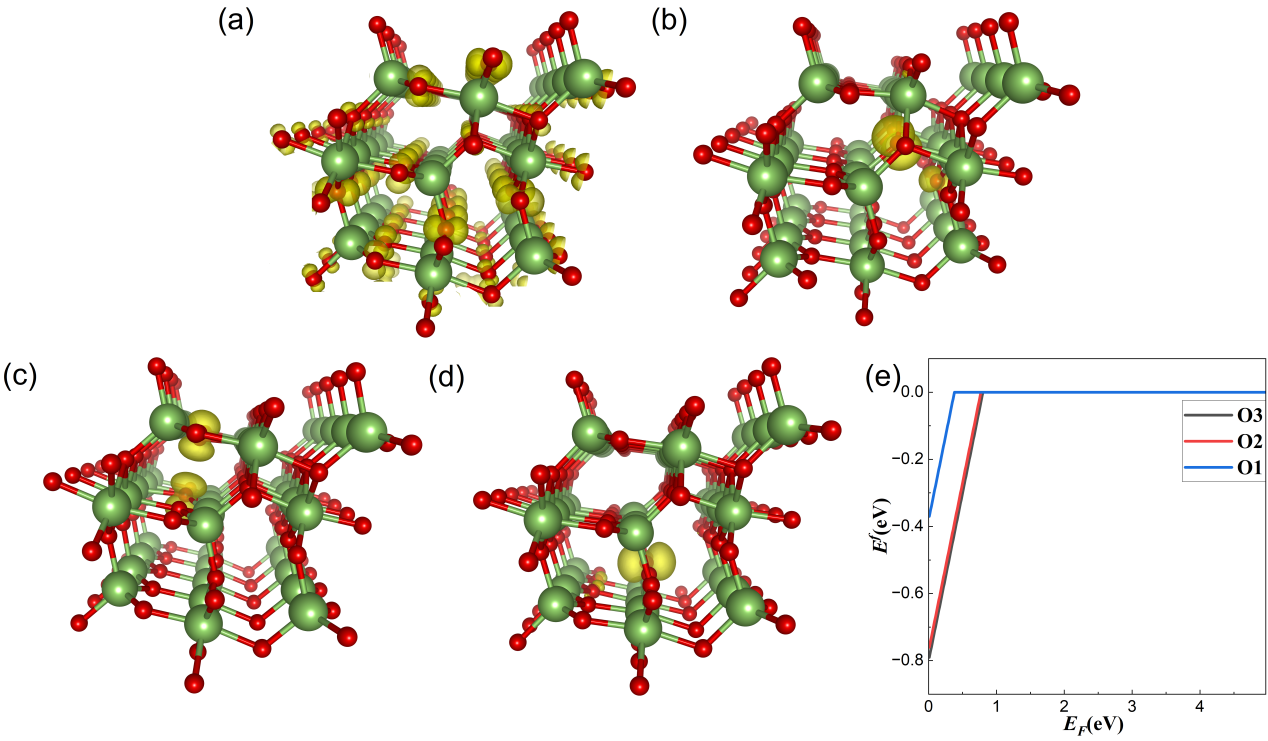
FIG. 1. Spin density of (a) non-local hole, (b) self-trapped hole on OI, (c) self-trapped hole on OII, and (d) self-trapped hole on OIII. (e) Formation energy of STHs in which 0 charge state corresponds to perfect crystal. The green balls represent the Ga atom, and the red balls represent the O atom.
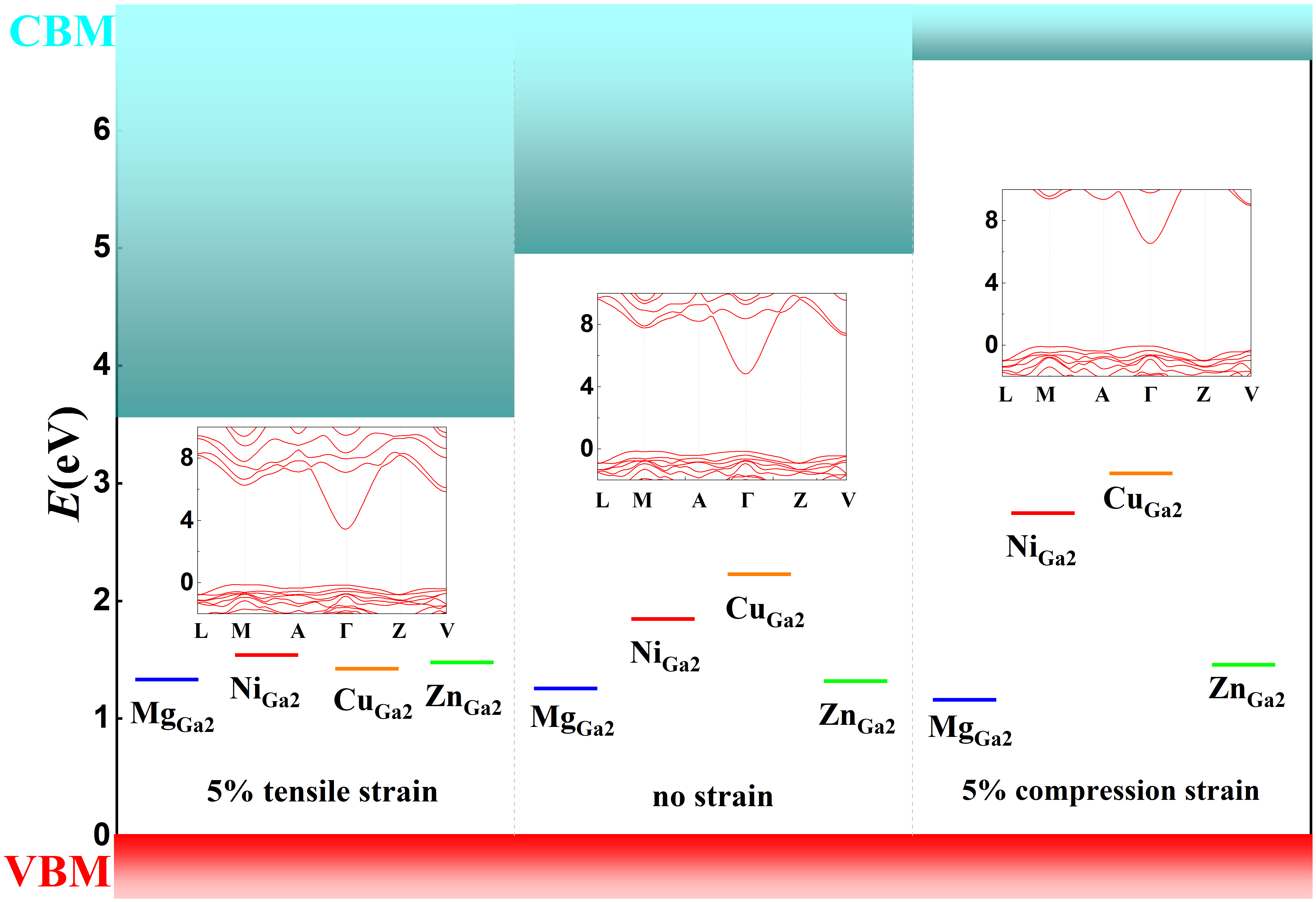
FIG. 2. Transition level ε(0/-1) of MgGa2, NiGa2, CuGa2, and ZnGa2 defects at 5% tensile strain, no strain, and 5% compressive strain, respectively. The band structure of β-Ga2O3 at various strain are illustrated in the inset.
DOI:
doi.org/10.1063/5.0266677
